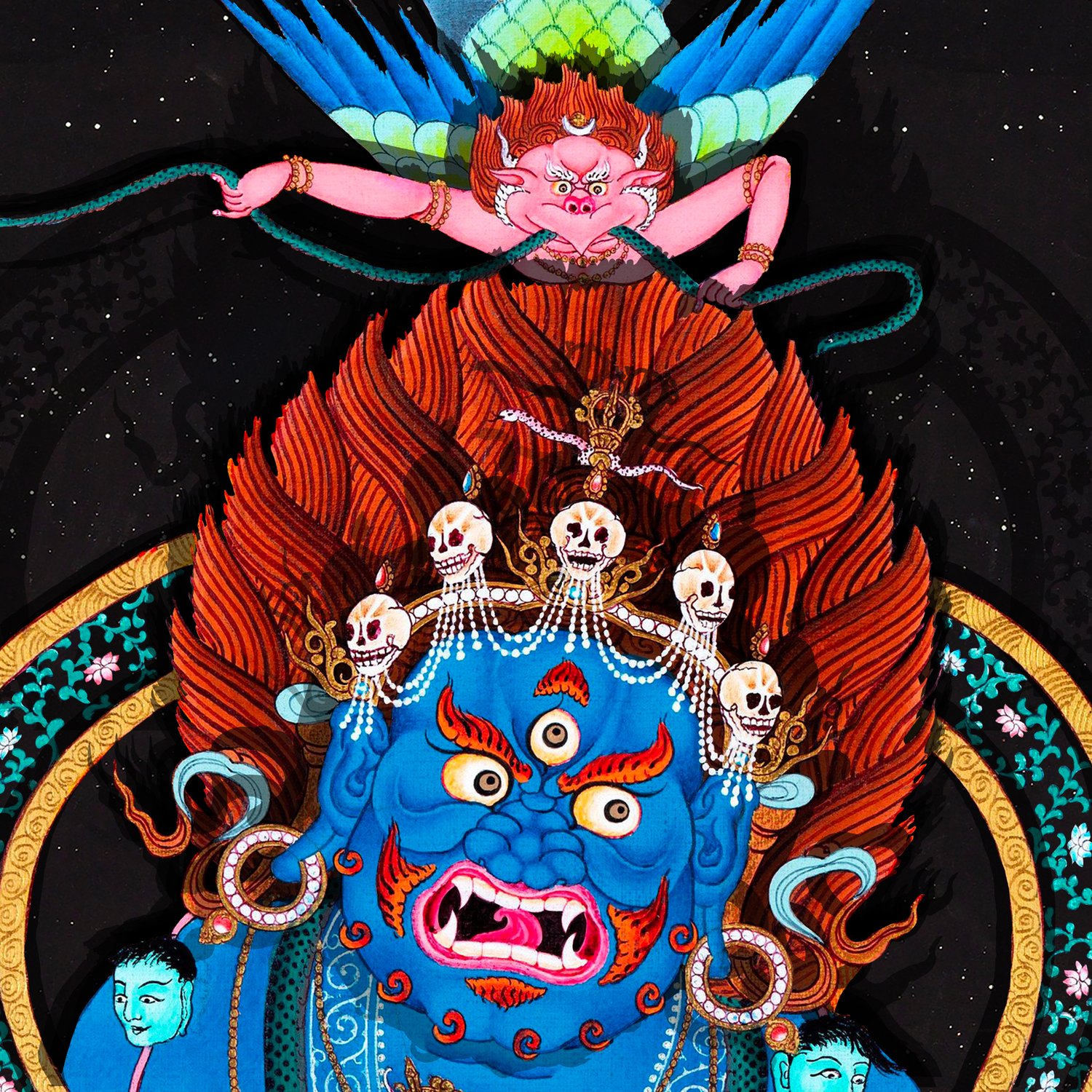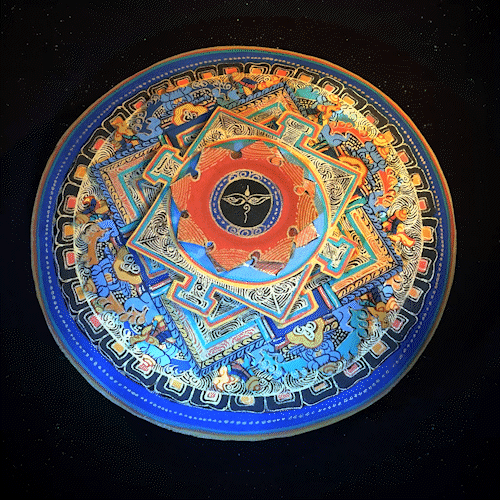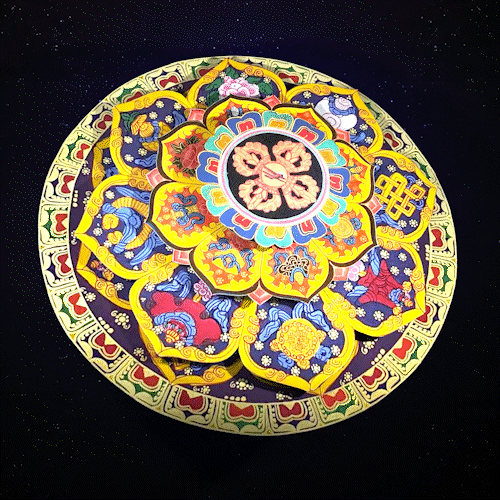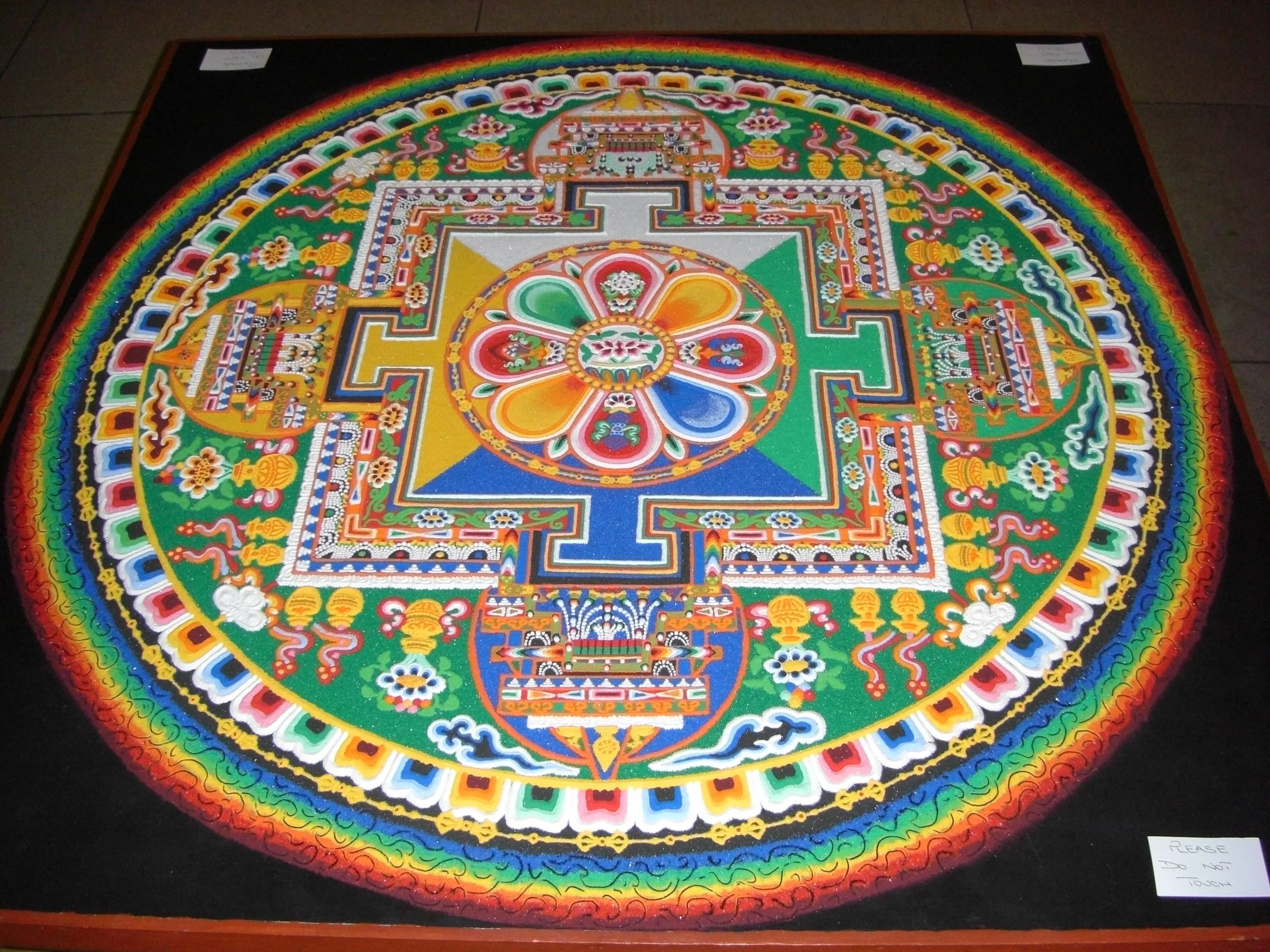Sacred Geometry and Buddhism: Mandalas as Portals to the Divine
What is a Mandala?
The term "mandala" originates from the ancient Indian language of Sanskrit and translates to "circle." However, the true essence of mandalas goes beyond their circular form. Mandalas are intricate, geometric representations of the universe, capturing both the microcosm and macrocosm within their intricate designs.
Mandalas are more than mere artworks; they serve as a visual gateway to profound spiritual experiences. Within the circular boundaries of a mandala, intricate patterns, geometric shapes, and vibrant colors merge to convey complex layers of meaning. It's important to note that while the term "mandala" might be unfamiliar to many, its symbolism and application are universal, making it a fascinating subject of exploration.
Origins of the Mandala
The beautiful and intricate art form known as the mandala has a rich history that spans across cultures and religions. Derived from the ancient Sanskrit word meaning "circle," mandalas are geometric designs that symbolize the interconnectedness of the universe and serve as a powerful tool for spiritual introspection and meditation. From the precise patterns of Tibetan sand mandalas to the vibrant and colorful Indian Rangoli designs, these intricate creations embody the essence of unity and harmony. While the fundamental meaning of mandalas remains consistent, the symbolism and interpretations behind them can vary greatly depending on the cultural and religious context in which they are found. Across the globe, from Buddhist temples to Native American artwork, the mandala serves as a visual representation of the deeper connections that exist between all beings and the greater cosmic forces at play. Whether used as a means of divination, a tool for healing, or simply as a visual expression of beauty, the mandala continues to captivate and inspire people around the world, offering a glimpse into the universal truths that bind us all together.
A mandala, with its intricate geometric pattern and captivating symmetry, holds a timeless allure that transcends cultural boundaries. The circularity of this sacred design represents the cyclical nature of life and the ever-changing universe. Throughout history, mandalas have played a pivotal role in diverse societies and religions, serving as powerful symbols of spiritual enlightenment and inner harmony. These mesmerizing creations find their place not only in the realms of art and architecture but also in the sacred rituals that connect individuals to their higher selves. As the eye navigates the labyrinthine pathways of a mandala, one cannot help but sense the profound depth of meaning that lies within its ornate borders.
Early Development in India (6th century BCE - 1st century CE):
Buddhist art has been using mandalas since the early days of Buddhism in India. As Buddhism spread, it brought not only spiritual teachings but also a unique visual language. Mandalas, which could be paintings, sculptures, or sand designs, were a part of this visual language. These early mandalas visually represented deep spiritual ideas and helped practitioners reflect on them. With their intricate patterns and symbolic elements, they guided people on the path to enlightenment. The development of mandalas in India was just the start of a journey that would cross centuries and cultures.
Spread to Tibet (7th century CE):
Buddhism came to Tibet in the 7th century. During this time, mandalas evolved. Tibetan Buddhists REALLY liked mandalas and made them more complex and meaningful. One well-known mandala in Tibet is the Kalachakra mandala, which shows time, the universe, and cosmic forces (2011 Kalachakra shown below). In Tibet, mandalas were used for thinking and also for rituals and meditation. They would make detailed mandalas with colored sands in special ceremonies, and then they would purposely destroy them to show that everything is temporary. This shows the important ideas behind mandalas in Tibetan Buddhism. They are like maps for the spiritual journey to become enlightened.
Esoteric Buddhism in Japan (9th century CE):
Japan adopted the mandala in its own way, with the help of Buddhist schools like Shingon and Tendai. The mandala became a visual way to teach spirituality and give insights through intricate artworks. Japanese mandalas, like the Womb World Mandala, combine Japanese culture with Buddhist ideas. They show celestial realms and how everything is connected, helping practitioners explore consciousness and reality. Overall, the mandala's origins in India, its evolution in Tibet, and its unique expressions in Japan show how adaptable and universal it is. Mandalas go beyond borders, cultures, and religions, serving as tools for spiritual exploration and visual representations of the cosmos. Their symbolism and importance grew over time, making them a treasured part of Buddhist art and spirituality.
Key Elements of a Mandala
Center Point (Bindu): At the center of each mandala is a single point called the Bindu. This point represents oneness, the origin of creation, and the ultimate aim of spiritual practice. The entire mandala stems from the Bindu, illustrating how everything is connected in the universe. When using a mandala for meditation, the Bindu is typically the starting point for focus and reflection.
Geometric Shapes: Mandalas are renowned for their intricate geometric patterns, which include circles, squares, triangles, and lotus petals. Each shape within a mandala carries specific symbolic meaning. The circle, for example, represents wholeness and unity, while squares symbolize stability and the material world. Triangles can signify upward or downward movement, reflecting spiritual ascent or descent, while lotus petals evoke purity and enlightenment. The combination of these shapes creates a symphony of symbolism within the mandala's intricate design.
Four Gates: A common feature in many mandalas is the presence of four gates, often positioned at the cardinal directions—north, south, east, and west. These gates symbolize not only the physical directions but also the psychological and spiritual pathways that lead toward enlightenment. As one navigates the mandala, they embark on a journey through these gates, representing different aspects of the human experience and the path to spiritual realization.
Outer Circumference: The outer boundary of a mandala serves as a sacred enclosure, encapsulating everything within its perimeter. This boundary represents the universe, both known and unknown. It is a reminder that everything within the mandala's sacred space is interconnected and interdependent, reflecting the Buddhist concept of inter-being.
Color and Symbolism: Colors within a mandala are not chosen at random; they are laden with symbolism. For instance, white represents purity and transcendence, red symbolizes passion and transformation, blue conveys wisdom and the infinite, and green represents harmony and balance. Symbols and deities within the mandala further enrich its meaning, with each figure embodying specific aspects of Buddhist teachings and spiritual ideals.
By comprehending these important parts, we can gain insight into the deep symbols and meanings within a mandala. Each part adds to the complex message of the mandala, encouraging people to explore their own thoughts and feelings.
Significance of Mandalas
Spiritual Guidance:
Mandalas are important tools for meditation and spiritual contemplation. By looking at a mandala and thinking deeply about its intricate details, people can go on an inner journey that transforms them. The mandala's balance and symmetry create a feeling of order and harmony that is very calming. Its detailed patterns and symbols are like a map that shows you how to get to deeper levels of awareness. Through this meditation, people can gain understanding, find inner peace, and find their own path to reaching enlightenment.
Sacred Spaces:
In a mandala, the line between what is sacred and what is ordinary becomes blurry. It is a place where divine and human worlds come together. This represents the possibility of experiencing spiritual awakening and realizing that the sacred is present in all aspects of life. When a mandala is made or looked at, it creates a feeling of connection with the spiritual world. It invites people to go beyond their normal lives and touch something wonderful.
Teaching Aids:
Mandalas are very helpful teaching tools in Buddhism. They make complex spiritual and philosophical ideas easier to understand by showing them visually. They capture the essence of how Buddhists see the world, with its gods, realms, and spiritual powers. Whether you are just starting to learn about Buddhism or you are very experienced, mandalas are like textbooks that help you see and understand the details of Buddhist beliefs and practices.
The world of Buddhist mandalas is a profound and multifaceted one, steeped in history, symbolism, and spirituality. From their early origins in ancient India to their evolution in Tibet and Japan, mandalas have continued to inspire and guide countless individuals on their spiritual journeys. Whether as tools for meditation, gateways to sacred realms, or visual representations of profound teachings, mandalas have an enduring significance that transcends time and cultural boundaries. Thus, the next time you encounter a mandala, take a moment to appreciate the intricate beauty and the hidden depths of meaning that lie within its sacred geometry. In doing so, you may find yourself embarking on a transformative journey of your own, guided by the wisdom of this ancient and revered art form.









